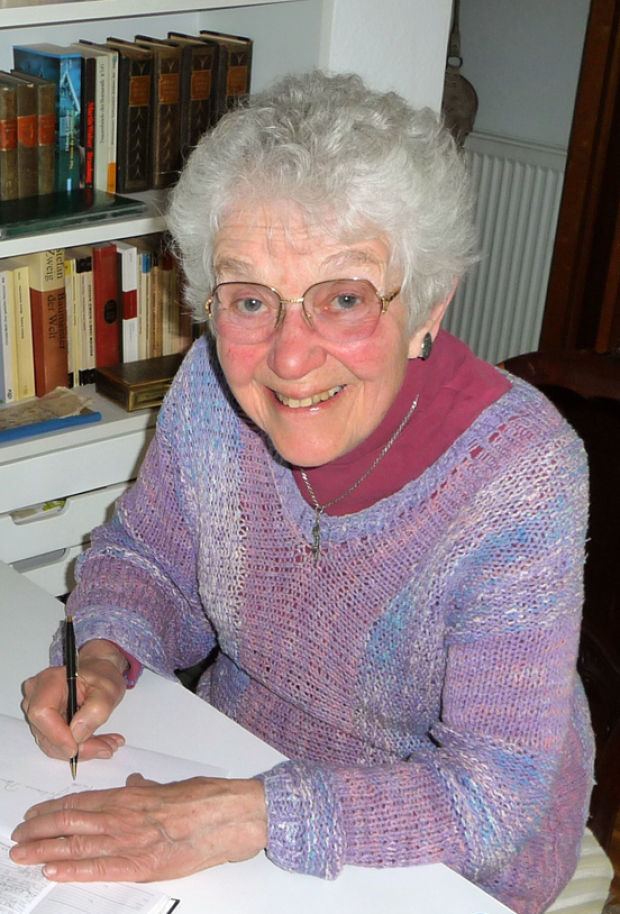Full Name Hannelore Klein Name Laureen Nussbaum Ethnicity Jewish Role Historian | Occupation Historian, writer Spouse Rudi Nussbaum (m. 1947) Known for Holocaust survivor | |
 | ||
Residence Portland, Oregon, United States Similar People Anne Frank, Margot Frank, Courteney Cox | ||
Laureen nussbaum remembering anne frank
Laureen Nussbaum (born Hannelore Klein, August 3, 1927) is a German-born linguist and writer. She is best known for being a Holocaust survivor, a Holocaust educator and for being a childhood friend of the famed memoirist Anne Frank. Nussbaum is frequently consulted on Anne Frank works and literature.
Contents
- Laureen nussbaum remembering anne frank
- Laureen nussbaum
- Friendship with Anne Frank
- Holocaust
- Life in America
- In literature
- References
Nussbaum was a professor of Foreign Languages and Literature at Portland State University. After retirement Nussbaum now lectures on the Holocaust, Anne Frank and her experience during World War II. While at Portland State, she also became the head of the German section of the Foreign Language Department. Nussbaum's publications on 20th-century German literature are often referenced in academia.
Laureen nussbaum
Friendship with Anne Frank
Nussbaum was born Hannelore Klein in Frankfurt, Germany. As Germany became increasingly hostile toward Jews, Nussbaum's family moved from Frankfurt to Amsterdam in 1936. In her new neighborhood, Nussbaum met Anne Frank. Nussbaum's family and the Frank family had been friends in Frankfurt, though Nussbaum had not known the Frank children at that time. Nussbaum became closest to Anne's sister Margot. While growing up together, Nussbaum remembers Anne as "vivacious and smart", though the two were not particularly close. In fact, Nussbaum was "rather indifferent" about Anne, considering her a "noisy chatterbox" and "a shrimp".
After Anne and most of her family were killed, Nussbaum remained close to Otto Frank, Anne's father and the only surviving member of Anne's immediate family. Otto was the best man at Nussbaum's wedding to Rudi.
Nussbaum has written about the fact that different version's of Frank's diary have been released, some with pages missing and some with only passages removed. Otto has been criticized in the media for the way in which the manuscripts have been handled, with Nussbaum commenting "He was headstrong and misled people on the content." She also stated "Otto should be congratulated for probably being the first to publish a document from the Holocaust."
Of the memory that she keeps of Anne, Nussbaum stated in 1995 "Memory easily fools you and my memory is coloured, inevitably, by the fact that she has become so famous. I always found her lively and keen, but would never have thought she would turn into this icon. I am afraid the icon has become, for some people, a source of income and the person Anne is obscured by this. She stands as a symbolic figure upon whom the world can heap both its guilt and its commiseration."
Holocaust
The Klein family moved to Amsterdam in 1936 to escape the increasing antisemitism in Germany. When the Nazis invaded the Netherlands in 1940, however, Jews were barred from many public places and in 1942 were forced to wear yellow stars on their clothing to denote their ethnicity. At the time of the invasion Nussbaum was fourteen.
The Klein family was able to obtain forged papers saying they were only part Jewish, thus avoiding deportation and being killed. They did not have to wear the yellow star on their clothing and moved about society without issue.
Nussbaum first met her future husband Rudi Nussbaum in Amsterdam, and acted as liaison for him while he was in hiding. Rudi refused to wear the yellow star and hid for four years before the war ended, at first living with Dutch peasants, then in the countryside, and finally in the Klein home. The two married in 1947, two years after the war had ended. Of the experience Nussbaum stated "I would not have chosen, at the age of 13 or 14, a deep sense of obligation that someone was dependent upon you. But in all situations in life, you have to rise to the occasion. We decided the other person was decent and worth it."
Life in America
In 1954, Nussbaum, along with her husband and children, migrated to Indiana so that Rudi could complete post-doctoral research for his degree. Together Nussbaum and Rudi had three children together; one daughter and two sons. It was upon migration that Nussbaum changed her first name from Hannelore to Laureen.
In 1959, Rudi gained a position at Portland State University and the family moved to Portland, Oregon. Nussbaum herself then gained a position at Portland State in the Foreign Languages and Literature department, eventually heading the German language department. After teaching courses for many years, she became Professor Emerita of the institution.
On July 22, 2011, Nussbaum's husband Rudi died after taking a fall in the Amsterdam Airport while the two were on holiday. After his funeral, he was cremated in Holland. The funeral was followed by a memorial service at the University Place Hotel and Conference Center in Portland.
In literature
Stand-alone books that Nussbaum has written (as compared to her many articles) include:
Nussbaum's work has been referenced in dozens of books, with some titles including:
